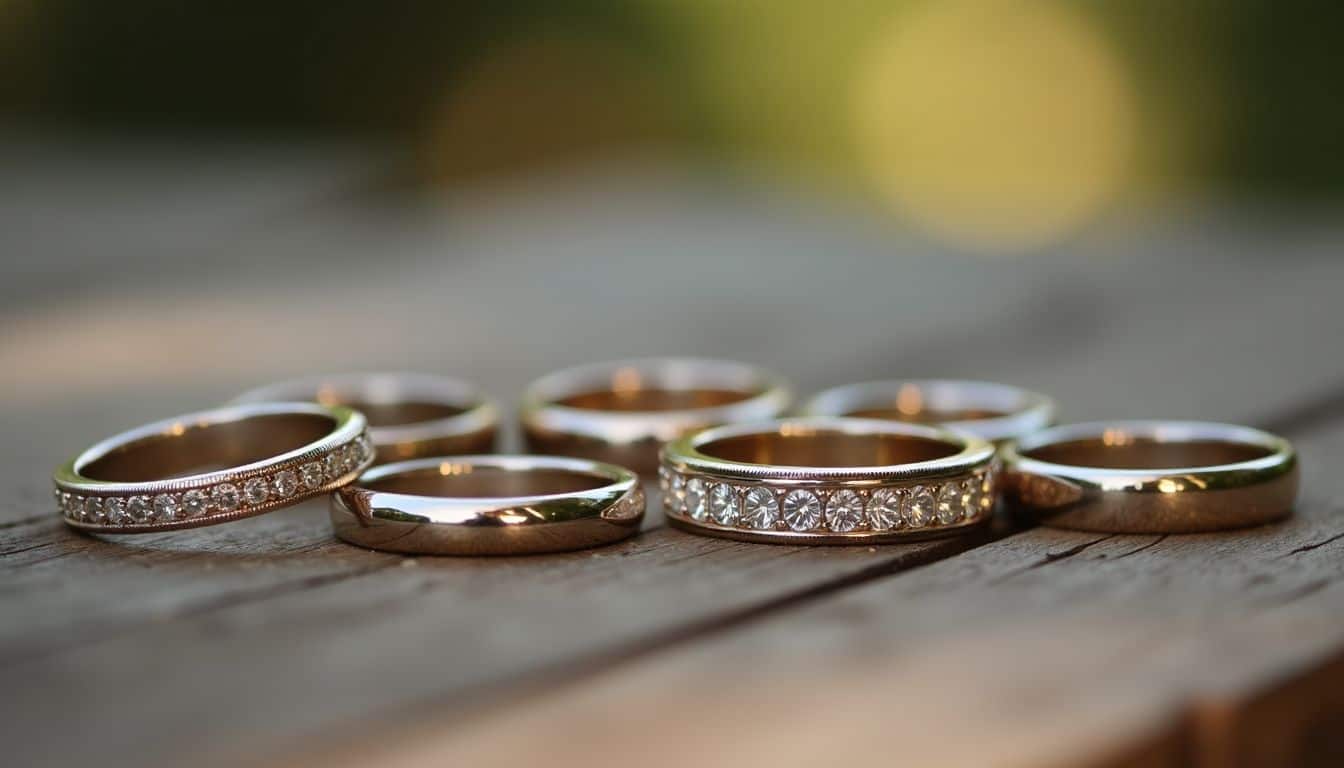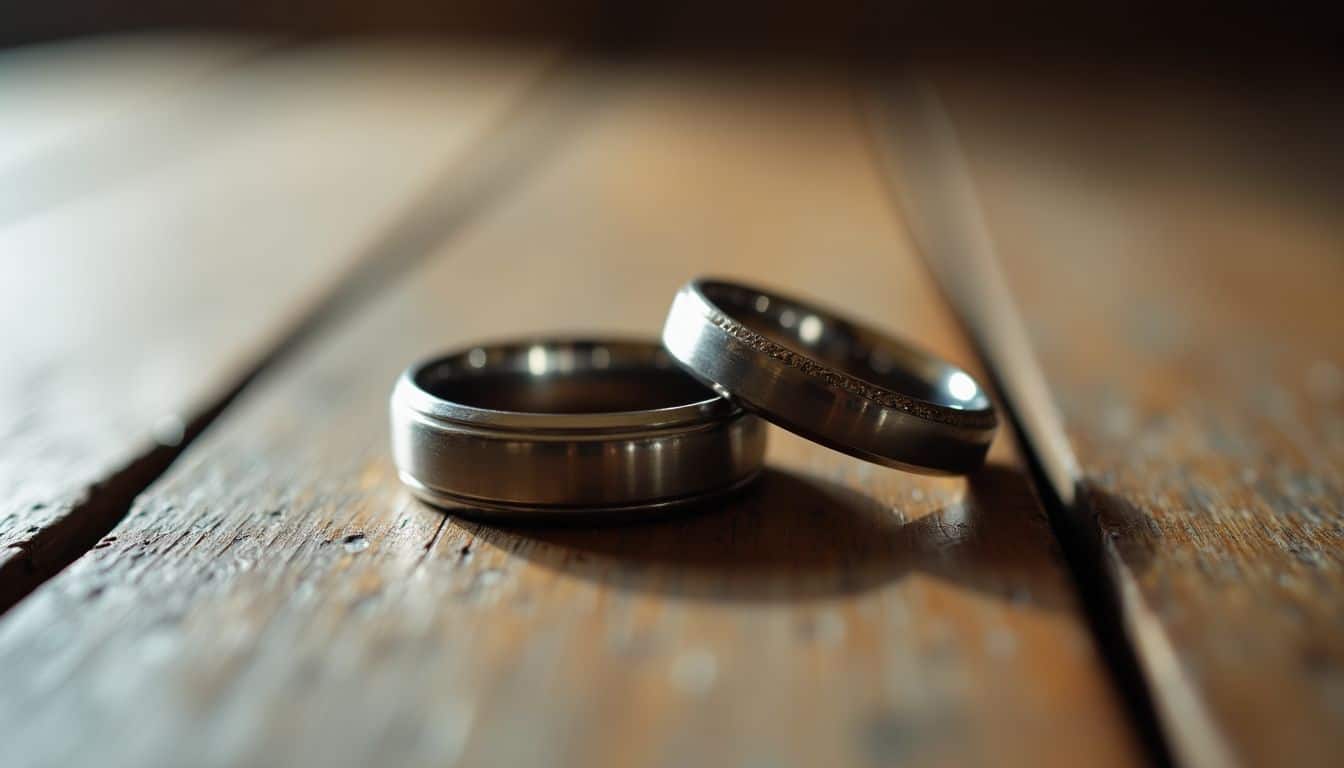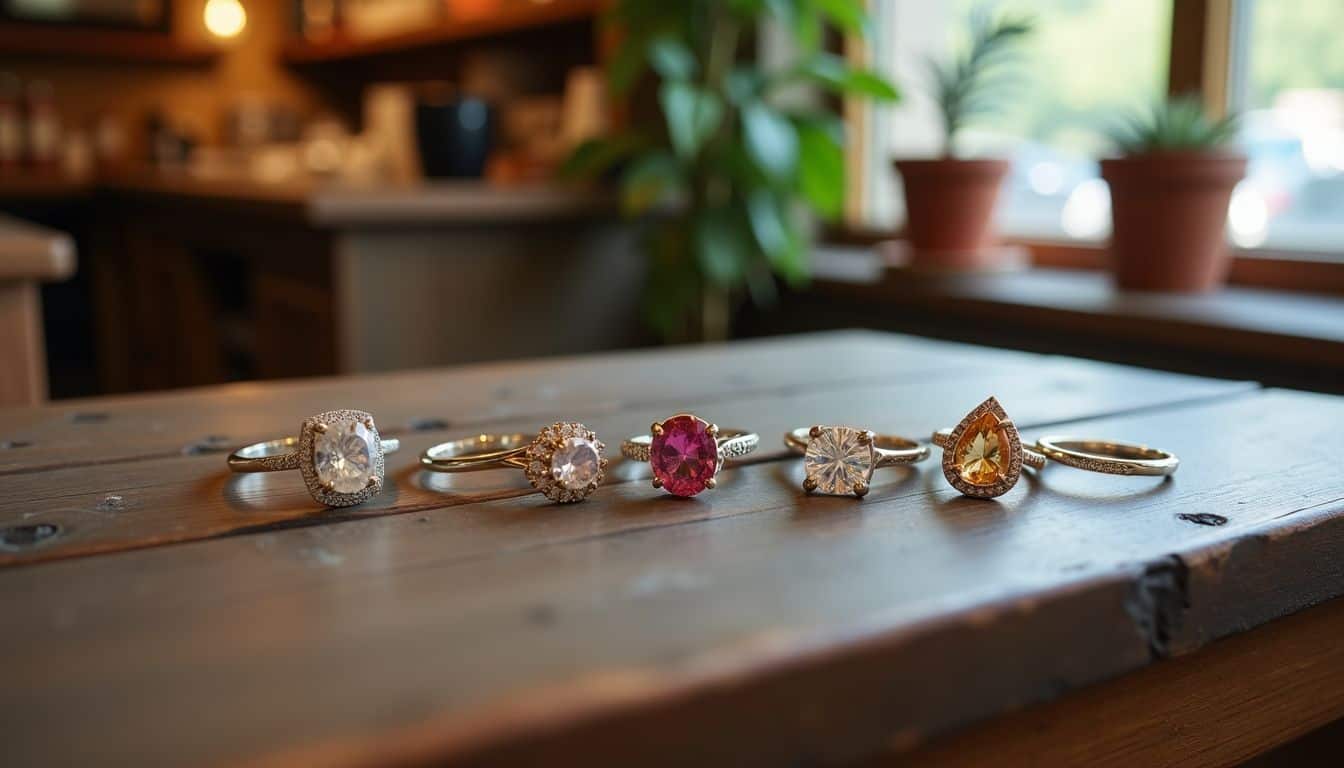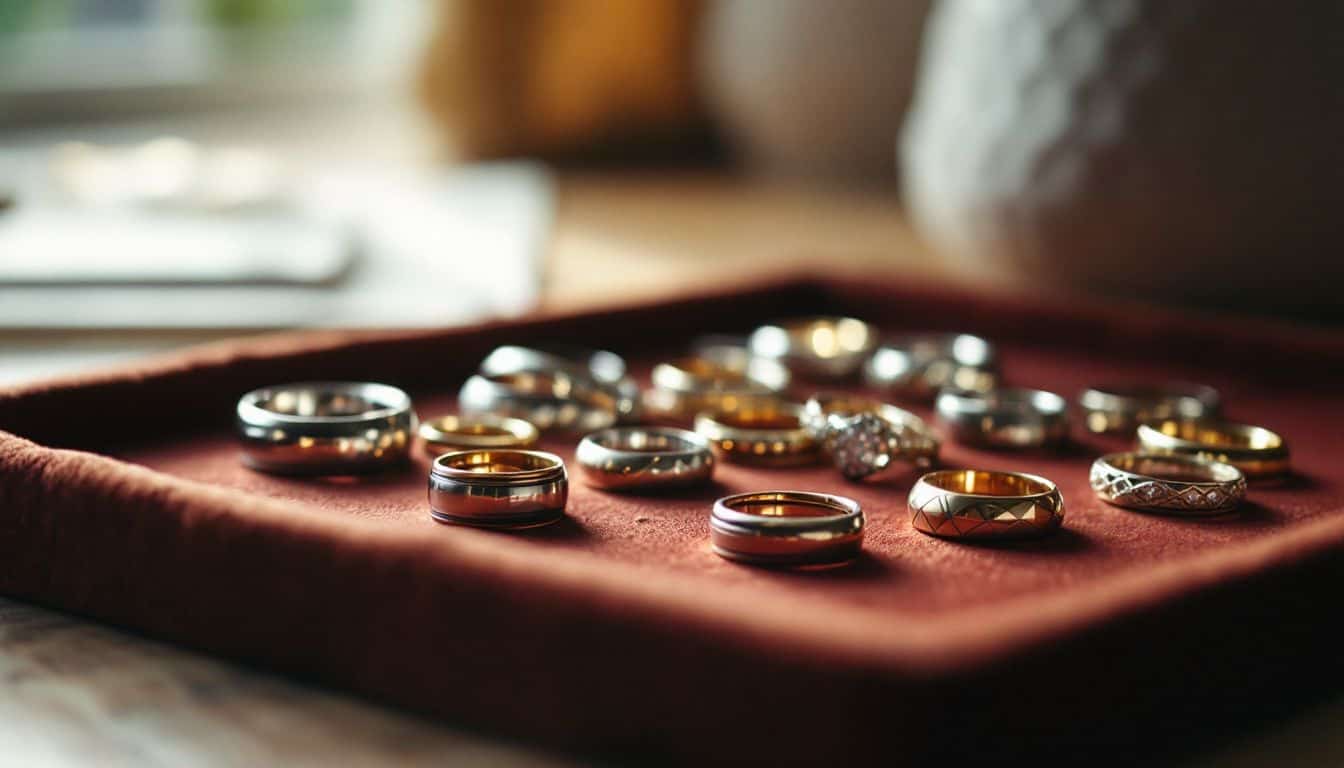Picking a wedding band that matches your engagement ring can feel like a puzzle. Most brides spend 3–4 months searching for the perfect wedding band to pair with their engagement ring.
This guide will walk you through metal choices, ring styles, and smart tips to find your ideal match. Get ready to discover how to pick a wedding band to match your engagement ring – minus the stress and confusion.
Key Takeaways
Most brides take 3–4 months to find their perfect wedding band match, with metal choices being the first key factor to consider.
Matching metals create harmony, while mixing metals (like white gold with rose gold) can add modern contrast and visual depth to your ring stack.
Wedding bands come in four main styles: classic plain bands, diamond eternity bands, stackable bands, and contoured bands that curve around the engagement ring.
Different diamond cuts need specific band matches – round cuts work with most bands, while pear and oval cuts often need custom-fitted curved bands for the best fit.
The ring’s setting affects band choice: solitaires work with most bands, halos may need curved bands, and bezel settings pair best with simple classic bands that don’t compete for attention.
Table of Contents
Consider the Metal of Your Engagement Ring

Your engagement ring’s metal sets the tone for your wedding band choice. A perfect metal match creates a stunning stack that will sparkle on your finger for years to come.
Matching metals

The metal of your wedding band should match your engagement ring for a classic look. White gold pairs well with white gold, and yellow gold looks perfect with yellow gold. Most jewelers suggest sticking to the same metal type to create a smooth, unified appearance.
Rose gold has gained popularity as a romantic choice that works beautifully with both white and yellow metals.
A matching metal set creates harmony that lasts a lifetime
Metal mixing can work too, but needs careful planning. The combination of white gold and rose gold creates a modern two-tone effect that many brides love. I’ve seen stunning combinations at jewelry stores where platinum bands complement white gold engagement rings perfectly.
The key lies in picking metals that share similar durability levels to prevent uneven wear over time.
Mixing metals for contrast

Beyond matching metals, mixing different metals creates stunning contrast in your ring set. Just like how contrasting personalities look great together, mixed metals bring out the best in each other.
White gold paired with yellow gold makes both metals pop with brilliance. Rose gold adds a warm, romantic touch to white gold engagement rings. Many brides mix white and yellow gold to create depth and visual interest in their ring stack.
Metal mixing works well with various diamond cuts too. A white gold engagement ring with an emerald-cut stone looks striking next to a yellow gold wedding band. This mix draws attention to both the metal and stone.
Some couples choose three-tone combinations using white, yellow, and rose gold for a modern twist. The key is picking metals that complement rather than clash with each other.
Decide on the Fit

The fit of your wedding band matters as much as its style. Your ring should slide smoothly on your finger and sit snug against your engagement ring without any pinching or gaps.
Flush fit vs. gap fit

A flush fit creates zero space between your engagement ring and wedding band. Your rings sit perfectly together, like two puzzle pieces meant for each other. I learned this firsthand while matching a women’s wedding band to my high-set solitaire engagement ring.
High-set rings make flush fits easy because they leave room underneath for a straight band to nestle close.
Gap fits show a small space between your rings. Most low-set engagement rings create natural gaps with wedding bands. Many brides love this look because it highlights each ring’s beauty.
A perfect ring fit is like a perfect marriage – it’s all about finding the right match and making it work beautifully together.
My sister chose this style for her bezel-set sapphire ring, and it lets both rings shine on their own.
Comfort and practicality

Your wedding band needs to feel good on your finger every day. The ring should slide smoothly over your knuckle without pinching or catching. Many brides pick comfort-fit bands with rounded inner edges.
These bands prevent skin irritation during daily tasks like typing or washing dishes. The width of your wedding band matters too. Wider bands might feel bulky with certain engagement ring styles.
The right fit keeps both rings stable on your finger. Some brides choose to solder their engagement ring and wedding band together. This stops the rings from spinning or rubbing against each other.
Your lifestyle plays a big role in ring comfort. Active brides might prefer lower-profile bands that won’t snag on clothes or equipment. Let’s look at different wedding band styles that match various engagement ring settings.
Explore Different Wedding Band Styles

Wedding bands come in many styles to match your sparkler, from plain metal bands to diamond-studded showstoppers. You’ll find options that range from classic single bands to modern stacking sets that create a bold statement on your finger.
Classic bands

Classic metal bands stand as a top pick for brides who love timeless style. Gold, silver, and platinum bands offer a clean look that pairs well with any engagement ring style. These bands cost less compared to the cost of wedding decor, making them a smart choice for budget-minded couples.
A classic band is like a little black dress – it never goes out of style.
Plain metal bands shine in their simplicity and daily wear comfort. The smooth finish feels great against your skin and won’t snag on clothes or gloves. Many brides pick these bands because they work perfectly with their jobs and active lifestyles.
The bands come in different widths – from super slim to bold statement pieces that catch the eye.
Eternity bands
 Eternity bands sparkle with diamonds set all around the band. These stunning rings show off their brilliance from every angle. The diamonds catch light as you move your hand, creating a dazzling display of sparkle.
Eternity bands sparkle with diamonds set all around the band. These stunning rings show off their brilliance from every angle. The diamonds catch light as you move your hand, creating a dazzling display of sparkle.
Most brides love these bands because they stand for endless love and commitment.
The diamonds in eternity bands come in different sizes and settings. You can pick small stones for a subtle look, or larger ones for more drama. Many jewelers offer these bands in white gold, yellow gold, or platinum to match your engagement ring.
The stones sit in either channel settings or prong settings, each giving the ring its own special look. These bands work great as wedding rings or anniversary gifts.
Stacking bands

Stacking bands offer a fresh take on wedding ring styles. You can mix different metals, shapes, and stones to create your perfect look. The beauty lies in playing with various textures and designs that match your style.
Your stack might include plain bands, diamond-studded rings, or bands with colored gemstones.
These bands work great for special occasions or everyday wear. Stack them high or low based on your mood and outfit. Many brides start with two or three bands and add more on birthdays or anniversaries.
The best part? Each band can tell its own story through engraving or choice of stones. Your stack becomes a personal collection that grows with your love story.
Contoured bands
Contoured bands curve around your engagement ring like a perfect hug. These bands follow the exact shape of your center stone, creating a smooth, gap-free fit. Your rings will sit flush against each other, making them super comfy for daily wear.
The curved design stops any awkward twisting or turning on your finger.
A contoured band brings out the beauty of your engagement ring’s center stone. The gentle curve makes your diamond or gemstone pop even more. Many brides love how these bands work with their solitaire rings or halo settings.
Your jeweler can match the metal and style to your engagement ring for a perfect pair. Now, let’s look at how different stone shapes affect your band choice.
Match the Band to Your Engagement Ring Setting

Your engagement ring’s setting plays a big role in picking the perfect wedding band – from classic solitaires to eye-catching halos, each style needs its own special match. Want to learn the secrets of finding your dream ring combo? Keep reading!
Solitaire engagement rings
Solitaire engagement rings shine as the most classic choice for brides. The single center stone stands tall without any side stones, making it a perfect match for almost any wedding band style.
A plain metal band sits beautifully next to a solitaire ring, creating a timeless look. The clean lines of a solitaire ring also work great with diamond-studded bands for extra sparkle.
A solitaire ring is like a little star on your finger – it catches light from every angle and never goes out of style.
I’ve paired my round brilliant cut solitaire with a thin pave band, and the combo turns heads everywhere. The simple design of a solitaire lets you play with different band widths and styles.
You can go bold with a wide band or keep it dainty with a slim one. The metal choice matters too – platinum and white gold make popular picks for their durability and shine. Many jewelers can help match your solitaire’s metal perfectly to your band for a seamless look.
Halo engagement rings
Halo engagement rings sparkle with a circle of small diamonds around the center stone. The extra diamonds create a bigger look and add more shine to your ring. Most brides love this style because it makes their center diamond look larger without spending too much money.
A halo setting works great with any diamond shape, from round-cut to emerald cuts.
The perfect wedding band for a halo ring depends on its design and height. A straight band sits flush against some halo rings, while others need a curved band to fit properly. Many brides pick diamond bands to match their halo’s sparkle.
Simple metal bands also look beautiful and let the halo ring stay the star of the show. The key is to try on different bands with your ring to see what feels right on your finger.
Three-stone engagement rings
Three-stone engagement rings sparkle with extra brilliance. The center stone stands proud between two smaller diamonds or gemstones. This style brings more shine to your finger than a single diamond ring.
I’ve helped many brides pick their perfect three-stone rings at my local jewelry store. Most choose round diamonds for all three stones, but mixing shapes creates an eye-catching look.
Your wedding band needs special attention with a three-stone ring. The side stones might block a straight band from sitting flush. A contoured or notched band curves around the engagement ring’s stones.
This combo looks smooth and feels comfy for daily wear. Many of my clients love pairing their three-stone rings with diamond-studded bands for extra sparkle. Next, let’s look at how bezel-set rings match with wedding bands.
Bezel-set engagement rings
Moving from three-stone rings, bezel-set engagement rings offer a smooth, modern look. A bezel setting wraps your diamond in a metal rim, creating clean lines and extra protection.
The metal edge acts like a shield for your precious stone, making it perfect for active lifestyles.
Bezel rings pair well with simple, classic bands that don’t compete for attention. You can pick a plain metal band that matches your engagement ring’s metal color for a sleek look.
Some brides love to mix it up with stacking bands or add a thin diamond band for extra sparkle. The clean design of bezel settings means you won’t need to worry about prongs catching on clothes or getting knocked loose during daily tasks.
Pairing Suggestions for Different Stone Shapes

Your diamond’s shape plays a big role in picking the perfect wedding band match. Each stone shape needs a specific band style to create that eye-catching sparkle on your finger.
Round-cut
Round-cut diamonds shine as the most popular choice for engagement rings. Their classic shape creates a perfect match with almost any wedding band style. The round brilliant cut brings out the most sparkle through its 57 or 58 facets, making it a top pick for brides who love maximum brilliance.
A plain metal band sits flush against a round-cut solitaire, while a diamond-studded eternity band adds extra dazzle.
Pairing your round-cut diamond ring takes less effort than other shapes. The symmetrical nature of round diamonds works great with straight bands or curved designs. A contoured band follows the ring’s curves for a snug fit, while stacking bands create a modern look.
Next, let’s look at how oval-cut diamonds pair with wedding bands.
Oval-cut
Like their round siblings, oval-cut diamonds bring a classic touch to wedding bands. The oval shape creates an illusion of longer, slimmer fingers. East-West single prong oval bands make a perfect match for this cut.
The band sits flush against the engagement ring, creating a smooth line that flows naturally.
Your oval diamond sparkles bright with the right wedding band choice. A plain metal band lets the stone take center stage. Some brides love to mix metals for a bold look. A white gold engagement ring pairs well with a rose gold band.
The contrast makes both rings pop without taking away from the oval’s beauty.
Emerald-cut
Emerald-cut diamonds shine with clean lines and step-cut facets. These stones pair well with both classic and contoured bands, giving you plenty of style options. The long, rectangular shape creates a sleek look that draws attention to your ring finger.
Many brides love how this cut makes their fingers appear longer and more graceful.
A simple platinum band sits perfectly next to an emerald-cut stone. The metal’s bright white color brings out the diamond’s brilliance without competing for attention. For extra sparkle, try a pave band that matches your stone’s geometric style.
Next, let’s look at how to match bands with pear-cut diamonds.
Pear-cut
Pear-cut diamonds sparkle with a mix of round and marquise shapes. This teardrop style needs a band that hugs its curves just right. Custom-fitted bands work great here, letting the pear diamond shine without any gaps.
The contoured band design follows the ring’s outline perfectly, making both rings look like they were made for each other.
A crown-design band adds extra flair to your pear-cut ring. The raised details match the stone’s unique shape and create a royal look. I picked this style for my own pear-cut ring, and it sits flush against my engagement ring with zero wobble.
The metal colors match perfectly, and the whole set feels secure on my finger all day long.
People Also Ask
How do I match my wedding band with different diamond cuts?
For radiant cuts, marquise diamond, princess-cut, or asscher-cut stones, pick a band that follows the same shape. Your jewellery should flow together like two pieces of a puzzle.
What’s the deal with soldering rings together?
Soldering your wedding band to your engagement ring keeps them from rubbing against each other. The process is simple, but get a warranty first. Many jewelers certified by the Gemological Institute of America offer this service.
Can I mix different gems in my wedding set?
Yes! While diamond color matching is common, adding a ruby or other gems can make your set pop. Just remember to check the warranty of merchantability for any stones you pick.
What should I know about ring warranties and protection?
Read the fine print about damages and personal injury coverage. Check the choice of law and jurisdiction details. It’s like having insurance for your precious rings.
Are there special deals for wedding bands?
Keep an eye out for sweepstakes and special offers. But always read the representations and warranties before jumping into litigation over any ring-related issues.
